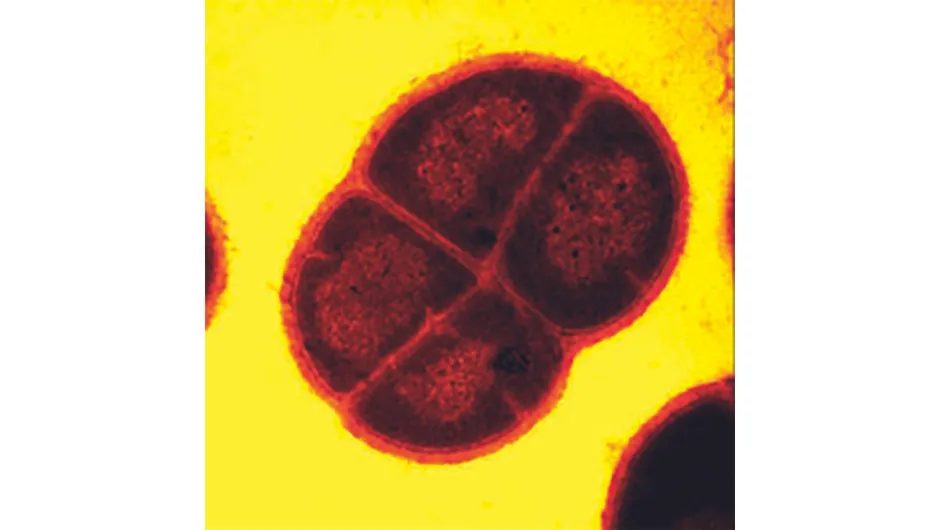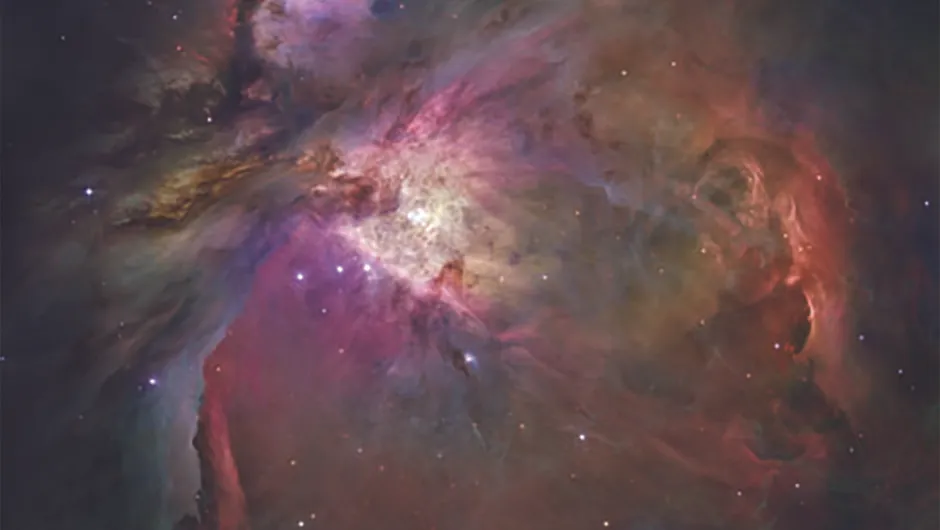One of the main difficulties of astrobiology, the search for life beyond Earth, is in knowing just what to look for.
Focus your attention too narrowly, by concentrating only on terrestrial-like life, and you could overlook alien organisms; consider too many possibilities and you could waste both effort and money looking for nigh-on unrecognisable variations in unlikely locations.
We obviously have only one example of a planet containing life to study, but we can be reasonably certain that we understand what sorts of attributes a chemical system must possess in order to be living, regardless of the molecules it might be built from or where it might call home.
So far, both NASA and the European Space Agency have focused on microscopic water- and carbon-based life forms like bacteria.
But astrobiologists are becoming increasingly aware of the need to keep an open mind and also search for ‘weird’ life, that is, organisms based on more exotic biochemistry.
Only this summer, a NASA-sponsored think-tank of more than 50 distinguished researchers released a report calling for a broadening of astrobiology research.
“It is critical to know what to look for in the search for life in the Solar System,” said Prof John Baross, committee chair of the National Research Council’s report.
“The search has so far focused on Earth-like life because that’s all we know, but life that may have originated elsewhere could be unrecognisable.”
New research shows that we may need to expand the search for life to more unlikely areas, even to the great ionised dust clouds that populate interstellar space.
What is organic life?
Life as we know it requires three fundamental functions: a self-description in order to reproduce; a network of chemical reactions to provide new building blocks and extract energy from the environment; and an outer envelope to contain it all.
A habitable environment for life must provide external sources of energy and a liquid solvent.
Terrestrial organisms are dependent on liquid water and organic biochemistry, and use carbon-based polymers for three essential tasks: information storage, metabolism and a containing membrane.
Information storage
All terrestrial life uses exactly the same genetic coding system of four ‘nucleobase letters’ supported on a long polymer backbone to form the DNA molecule.
Sequences of nucleobases selectively pair up with matching patterns so that two complementary strands of DNA bind together into the famous ‘twisted ladder’ double helix structure.
This provides the stability of DNA, as well as its astounding ability to replicate reliably.
Metabolism
To hold off its own decomposition and to extract energy from the environment, life must exert control over chemical reactions and run them at accelerated rates.
Terrestrial life does this using enzymes – catalysts built from protein molecules.
Proteins are themselves polymers of amino acids, each with different chemical properties, which fold up into highly specific three-dimensional shapes.
Much life on Earth, including all animals and fungi, also relies on an external source of organic molecules that are broken down to release chemical energy; humans call this food. Other organisms can extract energy from sunlight or inorganic chemical reactions.
Containing Membrane
All life on Earth is cellular – it is separated from the external environment within a membrane.
The chemical solution developed by water-bound terrestrial life is to use layers of water-repellent fatty acids (another organic polymer) capped by water-soluble heads.
The more complex terrestrial cells of animals and plants go one step further and are internally compartmentalised with these membranes to allow a higher degree of organisation.

The expert: William Bains, University of Cambridge Institute of Biotechnology
Are carbon-based, water-bound organisms like ourselves likely to be chemical freaks in the Universe?
We have no idea at all.
We look intothe sky and see things we think we can explain in terms of non-living processes.
Are we missing life, or is it just notthere? Do we lack the instrumentsor the understanding, or both?
As for terrestrial-like life, my guess is that most life will use some carbon; whether it uses water or not is another matter.
How plausible is inorganic life?
Entirely silicon-based life is not very feasible.
Silica is used sometimes in terrestrial biochemistry, and organosilicon molecules can be flexible and complex so carbon-plus-silicon life (in some ratio) is clearly an option.
Beyond that you can speculate wildly.
What about metallochemical life in lakes of liquid sodium on Mercury?
Although this sounds pretty far-fetched, we really do not know enough about life to rule such possibilities out.
Where’s the most likely abode in the Solar System for extraterrestrial life?
Mars, without a doubt – the evidence of biochemistry happening on Mars is quite strong now, and the evidence for water is very good.
But… is this terrestrial life?
Or are we descended from martians?
The planets are close enough to exchange life within meteorites.
Do you think we should already begin equipping probes to detect exotic life?
You would need a sophisticated chemistry laboratory complete with a scientist in a lab.
I don’t think we have the technology to start transporting that to places like Titan just yet.
How about exotic life here on Earth?
Exotic in terms of non-carbon, non-water life is very unlikely, but bizarre biochemistry is probable.
We are only just discovering that Earth’s crust may hold as much life as the surface ‘biosphere’.
These microbes might use forms of exotic energy metabolism.
Different life
It’s becoming increasingly apparent that many aspects of Earth life may not be absolutely necessary – alternatives would function just as well.
“Experiments have shown that the DNA alphabet is not limited to the four standard letters known in terran DNA,” the report explains. This represents only a minor tweak to the terrestrial system, though.
What about more radical deviations? Which exotic chemistries might also be suitable for life?
Perhaps ones that shirk the ‘water chauvinism’ or ‘organocentricism’ that has so far dominated astrobiological thought.
The solvent that Earth life depends on is liquid water, but the research committee “found no compelling reason to limit the environment for life to water as a solvent”.
They highlighted formamide, which remains liquid at much higher temperatures than water, and so may offer a wet environment for life on hot, desert worlds.
Ammonia, on the other hand, is liquid at much colder temperatures, and would therefore be a suitable solvent for organic molecules that have substituted nitrogen atoms for oxygen.
Non-terrestrial organic biochemistry is also possible in otherwise noxious compounds, such as sulphuric acid or hydrogen peroxide.
A sufficiently adapted carbon-based biochemistry is plausible in the liquid methane and ethane on Titan, a prospect the astrobiology committee took seriously enough to suggest that maybe “the planned missions to the Solar System should be reordered to permit returning to Titan earlier than now scheduled”.
An even more extreme possibility is carbon dioxide under such a high pressure that it enters a liquid-like ‘super-critical’ phase, which may offer liquid habitats on planets such as Neptune or Venus.
And what about challengers to the assumed superiority of carbon for biochemistry?
Silicon is often named as a strong contender because in many ways its chemistry is very similar to carbon.
“There is little question that many polymers – the long, repeated chains of molecules that form the building-blocks of life – are possible using silicon, rather than carbon, as a scaffolding,” states the NRC committee.
However, complex silicon molecules are all too fragile under terrestrial conditions, and so silicon-based life could survive only in more extreme environments.
Astrobiologists, such as Washington State University’s Dirk Schulze-Makuch, have identified three different kinds of silicon molecules that may support life.
“Silanes, silicones, and silicates are all possibilities,” he says, “but require very different environments.”
Polysilanes may be equivalent to the hydrocarbons that form the fatty membranes of terrestrial life.
“The problem with silane polymers,” Schulze-Makuch explains, “is that they must be kept cold or under high pressure to prevent them breaking apart.
They are also much more reactive than their organic equivalents, spontaneously combusting in oxygen and decomposing in water.”
Silicones, hybrid polymers of silicon and organics, are more resistant but still need a solvent other than water.
The liquid hydrocarbons such as methane or ethane found on Titan would do nicely, and the NRC report also emphasises the truly chilly liquid nitrogen thought to lie beneath the surface of Neptune’s moon Triton, considered a likely locale for exotic life by University of Cambridge biotechnologist William Bains.
But silicon chemistry might really come into its own at the truly rock-melting temperatures of liquid silicates.
Silicate compounds are rife in the Solar System, forming the rocks of Earth’s crust and mantle.
Silicate-based life is a possibility within the molten interior of any fair-sized rocky planet or moon, such as the volcanic jovian moon Io.
Schulze-Makuch is cautious, however. “If magma life does exist, why have we never spotted fossils of silicate life-forms in volcanic rocks?” he asks.
The National Research Council report even considered weird ‘solid-state’ life surviving within the frozen water of comets or ice-coated silicate dust grains on the outskirts of the Solar System (see left picture).
Such a life-form might survive off the trickle of chemical energy delivered by cosmic radiation, and so metabolise and reproduce at a truly glacial rate.
In fact, new research indicates that silicate dust grains may not just host exotic life, they may possess life-like qualities themselves.
Interstellar space is shot through with silicate dust in great nebulous gas clouds, which become ionisedby nearby stars, turning them into plasma, an electrically charged gas.
When a team of Russian scientists, led by Vadim Tsytovich, recently ran computer simulations and laboratory experiments to investigate the properties of this plasma, they discovered that an amazing degree of self-organised complexity was possible within these nebulae.
Results showed that the nebulae were electrically active, with clouds of charged dust grains interacting with each other and with fluxes in the plasma.
The interplay of these effects generated a powerful attractive force, a million million times stronger than their mutual gravity, which pulled the dust motes together into spherical structures known as plasma crystals.
Within these spheres, the grains were a set distance apart and interacted in a fluid-like state.
The team found that if there was any slight asymmetry in the spherical plasma crystals, then they would change shape into a double helix of corkscrewing dust grains about 5mm in length, aligned along the local electric field lines.
Astoundingly, Tsytovich’s group realised that these stable helices could also store information along their lengths, coded in a sequence of sections with tightened coiling.
Outside the swirling tubes, cells of dust convection were set up.
Tsytovich believes the crystals are able to pass on their coding sequence to a neighbour through the tubes, as the helical plasma crystals are attracted to each other.
Individual tubes also need to compete for available raw materials – free-floating dust grains – weeding out the weaker helices until only those with the greatest attractive force would survive.

The expert: Dirk Schulze-Makuch
What do you think is the most plausible alternative biochemistry?
Martian organisms using a hydrogen peroxide-water mixture as their intracellular fluid.
This would prevent cells freezing down to –55°C and allow them to scavenge water directly from the atmosphere.
Such a life-form would also explain many of the puzzling finds of the Viking life detection experiment.
How about exotic energy sources?
Terrestrial organisms use the chemical and light energy abundant on Earth but there is no reason why other energy sources would not be harvested on different worlds, such as magnetic fields, osmosis, and gravitational energy.
In a subsurface ocean like Europa’s, thermal energy could easily be envisioned as replacing light energy.
Where’s the most likely abode in the Solar System for extraterrestrial life?
Probably Mars.
It is hard to see how early Mars could have remained sterile given that microbial life could be transferred within meteorites from the teeming Earth nearby.
However, to find a separate origin of life, I think Titan is the most promising candidate due to its exotic conditions, which seem to provide everything life needs: liquid solvents on its surface (hydrocarbon and occasionally ammonia-water mixtures), plenty of organics and available energy.
Should NASA begin equipping probes to detect exotic life?
Yes. We need to free ourselves from the assumption that life on an extraterrestrial body has to be like us. We are talking about life on another planet or moon.
How about exotic life here on Earth?
Unlikely, but if any exotic life does exist on Earth it would have to exist in places where life as we know it is absent or struggles to exist – otherwise it would probably have been out-competed.
However, we are still unable to grow most micro-organisms and many search tools, for example, DNA sequencing, are biased towards life as we know it.
Where could life be found?
Titan
The best bet for life forms based on an exotic biochemistry in our own Solar System is Saturn’s enigmatic giant moon, Titan.
Last year, seas and lakes of hydrocarbons – probably methane – were discovered on the moon that may provide the perfect liquid habitat for silicon-based organisms.
In fact, because these lakes may be much more accessible to our robotic explorers, exotic life may be found here before we can explore the deep subsurface environments of the closer Mars or Europa.
The surface is so cold, a numbing –180°C, that chemical reactions will run very slowly and Titanic life may survive off bizarre energy sources, such as free radicals that are very hazardous to Earth life at a molecular level.
Europa
Beneath its frozen surface, this jovian satellite is believed to harbour a water-ammonia ocean, kept warm as the moon’s innards are constantly tugged and flexedby the powerful gravitational pullof the gas giant Jupiter.
This hidden ocean would hold more water than all the seas of the Earth, and may host alien life huddled around volcanic vents or even feasting on chemicals created by cosmic radiation striking the icy surface.
Venus
Venus is a truly hellish place, its lava-smothered surface baked by a powerful greenhouse effect.
But it may once have hosted oceans and Earth-like life before succumbing to environmental catastrophe, and perhaps microbes survive today in aquifiers deep beneath the surface.
Alternatively, sulphuric acid-based bacteria may thrive high above the scorched ground in the clouds, photosynthesising with the ultraviolet light from the Sun.
Mars
Mars has long been the traditional favourite for discovering organic life in space as it’s believed to have been much like Earth early in its history.
As the martian atmosphere leaked away and the climate plummeted, bacteria may have retreated further into the warm depths of the crust.
Alternatively, other microbes may have evolved a more exotic biochemistry to survive even today on the permafrost surface, filling their cells with hydrogen peroxide anti-freeze.
How to find exotic life
Use spectroscopy
All life must operate reactions at accelerated rates to keep ahead of environmental conditions and extract energy.
If life is present, chemical levels in the environment will be distorted away from the balance expected on the basis of natural reaction rates.
Astrobiologists can detect the biosignature of these imbalances lightyears away using telescopic spectroscopy, which involves analysing the light from different planets.
Hunt for light isotopes
The enzymes of life prefer to process the lighter isotopes of atoms (for example, carbon-12 over carbon-13) because they are easier to make and break chemical bonds with.
This causes ‘isotopic fractionation’ – the original ratio of light and heavy isotopes becomes split, with the organisms (or dead residues) containing a bias towards the lighter isotope.
Many different elements, such as iron, sulphur and silicon, could be used in this way.
Find complex molecules
Organisms use extracted energy to make complex molecules.
These would never form through normal conditions, so detecting pockets of complex polymers would be strong evidence for some form of life.
Exotic life on Earth

All known life on Earth descends from the same ancient ancestor, but might several fundamentally distinct life forms have arisen at the same time?
If so, alternative exotic life forms may survive today in isolated pockets on our planet, making up a shadow biosphere within oceanic abysses or deep inside the Earth’s crust.
Sufficiently bizarre life might even thrive right beneath our noses – most detection methods rely on DNA, for example, and so may simply miss other organisms.
Some researchers even claim alien immigrants have become integrated into our biosphere, delivered from elsewhere within meteorites or comets.
Deinococcus radiodurans, for example, can survive radiation doses thousands of times greater than those which kill other organisms – levels far higher than ever exist naturally.
Truly bizarre life forms may even survive in the most extreme environments: if silicate-based life is possible, it may swarm far beneath our feet in the rock-melting heat of the Earth’s mantle.

Self-organisation
These helical plasma tubes, described by Tsytovich as a “new complex state of soft matter”, are an example of spontaneous self-organisation.
“The complex, self-organised plasma structures exhibit all the necessary properties to qualify them as candidates for inorganic living matter,” adds Tsytovich, “
They are autonomous, they reproduce and they evolve.”
The researchers might just have witnessed the genesis of a primitive inorganic life form in their laboratory plasma chamber.
It’s a process that may have seeded our own organic-based life here on Earth, and it could be far more widespread throughout the Universe than we could ever have thought.
